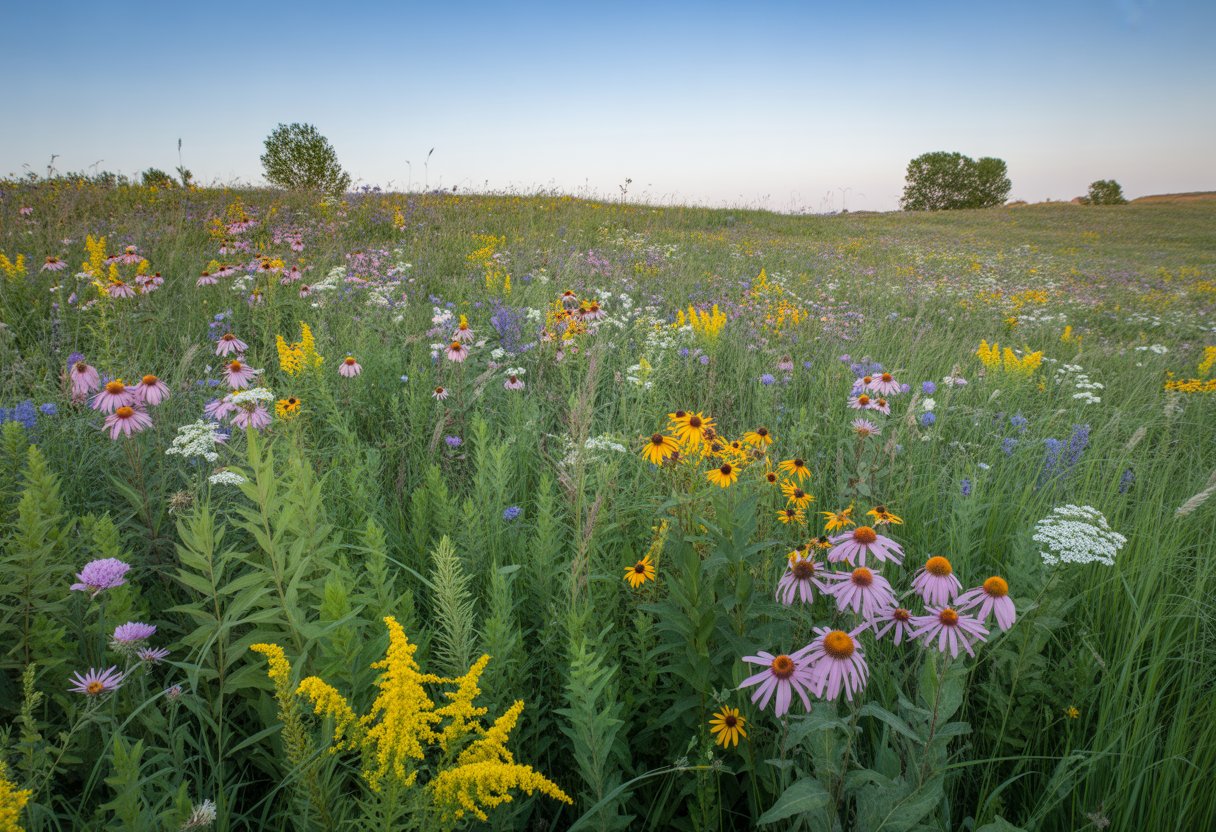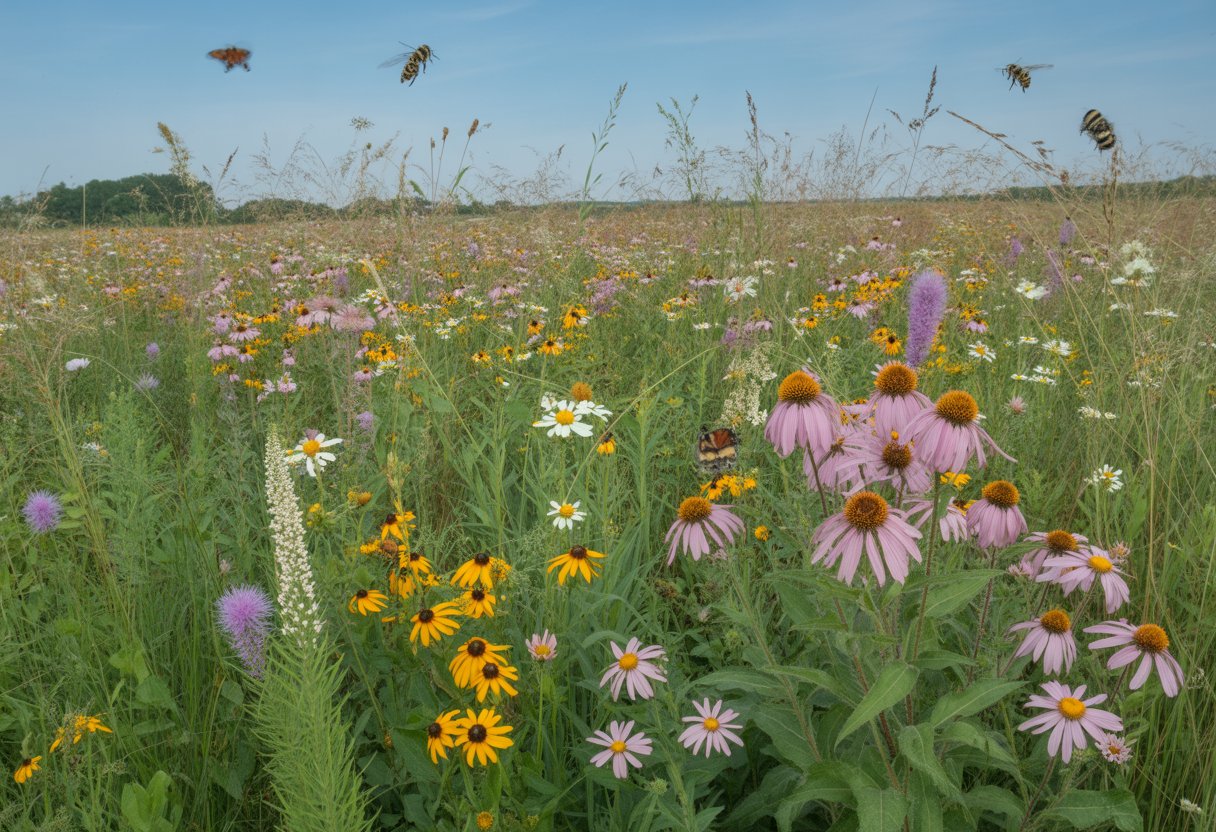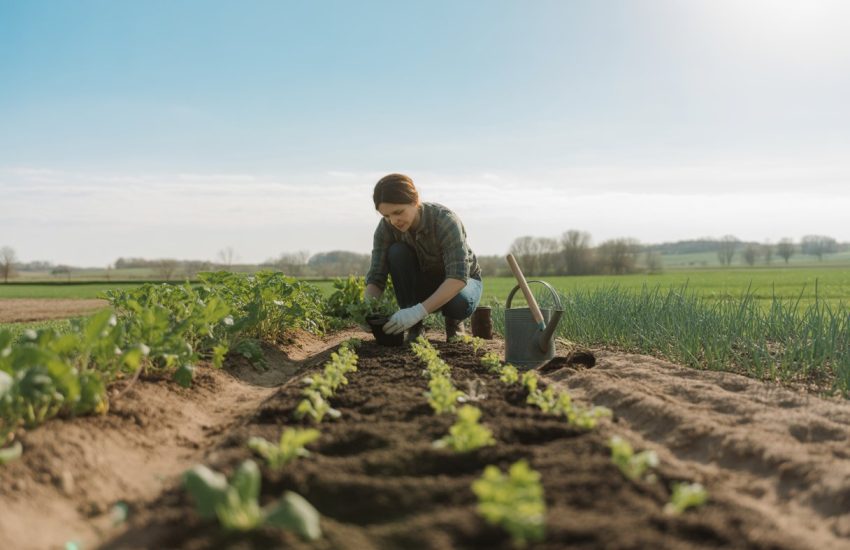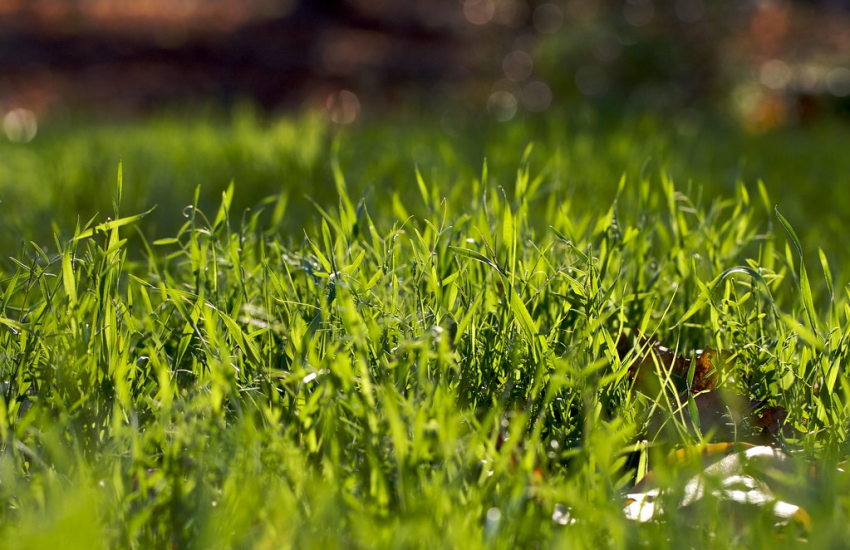Wildflower Meadow Planting Indiana Best Practices for Successful Growth
Planting a wildflower meadow in Indiana? It can turn plain land into a lively, sustainable habitat full of color and motion. Choosing native species that fit Indiana’s climate and soil is the real trick—less work for you, more support for local wildlife.

Indiana’s growing season and soil conditions work well for wildflowers like Black-eyed Susan, Purple Coneflower, and Wild Bergamot. If you prep your site and time things right, your seeds will settle in and create a meadow that’s both tough and beautiful.
Planning a Wildflower Meadow in Indiana
You’ll want to pay attention to plant selection, site conditions, and supporting local pollinators. Getting the planning right means your meadow stands a real chance in Indiana’s climate and soil.
Choosing Suitable Native Plants
Go for native plants that already know how to handle Indiana’s weather. The Indiana Department of Natural Resources and Purdue University both recommend purple coneflower (Echinacea purpurea), black-eyed Susan (Rudbeckia hirta), catchfly (Silene), plains coreopsis (Coreopsis tinctoria), and New England aster (Symphyotrichum novae-angliae).
Lean toward perennials and native grasses for a meadow that sticks around year after year. Match your choices to the site’s soil moisture—Indiana soils run the gamut from well-drained to soggy. Skip invasive species; they just muscle out the natives and tank your biodiversity.
A pollinator seed mix with a solid mix of flowers and grasses draws in all kinds of creatures: bees, butterflies, beetles, you name it. That kind of mix keeps Indiana’s native pollinators happy and busy.
Site Selection and Preparation
Pick a spot with full sun and well-drained soil if you can swing it. Some native species don’t mind a bit of shade or dampness, though. Test your soil to see what you’re working with—nutrients, moisture, all that.
Clear out invasive species and turfgrass first. Herbicides or solarization both help prep the ground, and Purdue University backs these methods for getting a seed bed ready. Try not to overdo the tilling; you want to keep the soil structure and its tiny residents intact.
Plant small native seeds shallowly—don’t bury them. Late fall or early spring works best for sowing, syncing up with Indiana’s natural cycles and giving seeds the cold they need.
Designing for Pollinator Diversity
Mix up flower shapes, colors, and bloom times to pull in different pollinators. Purple coneflower brings in bees, while New England aster helps out late-season butterflies.
A blend of perennials and grasses gives pollinators places to nest and overwinter. If you vary plant heights and bloom periods, you’ll keep food available all season.
Sourcing seeds locally boosts genetic diversity and helps plants adapt. Both Purdue University and the Indiana Department of Natural Resources push for this approach.
Check out regional seed mix tables or lists—they can really help when you’re picking species for maximum ecological benefit.
Establishing and Maintaining Wildflower Meadows
Getting a wildflower meadow going in Indiana takes some work up front—soil prep, timing, and sticking with it. If you keep up with care, you’ll support native plants and pollinators and keep invasives out.
Planting Methods and Timing
Late fall or early spring is the sweet spot for planting in Indiana. This matches up with how seeds naturally behave and lets winter cold help with germination.
Start by testing your soil’s texture and pH. The Indiana Department of Natural Resources says to remove old vegetation and give the soil a light till to tamp down competition.
A pollinator seed mix heavy on perennials works well with Indiana’s conditions. Scatter seeds evenly and press them in—don’t bury them more than a quarter-inch.
Managing Weeds and Invasive Species
Weed control early on makes a difference. If you mow or do a controlled burn, you’ll knock down annual weeds before they take over.
Keep an eye out for invasives like purple loosestrife and reed canary grass. Pull them by hand or spot-treat with herbicide while they’re small—don’t let them crowd out your natives.
Skip heavy fertilizing. Too much fertilizer just gives weeds a leg up. Focus on keeping soil moisture right and let your perennials outcompete the fast-growing weeds.
Ongoing Care and Maintenance
Once your meadow’s established, mow once or twice a year. The Indiana Department of Natural Resources recommends mowing late in the fall so you don’t stress your perennials or cut off their seed production.
Check soil moisture now and then. Wildflower meadows like well-drained soil but can use a bit of moisture during summer dry spells.
If you spot bare patches, re-seed with native stock every few years. Don’t overdo it with fertilizer or irrigation—those just help invasives, not your wildflowers.
Supporting Wildlife and Enhancing Biodiversity

Wildflower meadows in Indiana make a real difference for local wildlife. They boost genetic diversity among native plants and give animals what they need to thrive.
Attracting Pollinators and Beneficial Insects
A good wildflower mix brings in bees, butterflies, moths, wasps, flies, and beetles. These insects collect pollen and nectar, keeping pollination going for wild and garden plants alike.
Native bees and butterflies especially love flowers they’ve evolved with. By staggering flower blooms, you give pollinators food all season, which helps plant diversity too.
Hummingbirds show up for certain flowers as well, sipping nectar and helping with pollination. A varied plant mix really supports healthy pollinator communities and keeps the ecosystem resilient.
Providing Resources for Birds and Other Wildlife
Wildflower meadows don’t just help insects—they feed and shelter birds like hummingbirds and seed-eaters. Native plants such as pawpaw, serviceberry, mulberry, and persimmon provide fruit at different times of year.
The thick growth offers nesting spots and cover, keeping birds safe from predators. Plus, all those insects become food for birds, tying the whole food web together.
By maintaining meadows, you support both local and migratory wildlife and boost biodiversity in your area. These habitats matter, especially outside forests and cities.
Reducing Threats from Pesticides
Wildflower meadows act as safe havens, cutting down exposure to nasty insecticides like neonicotinoids. These chemicals mess with pollinators, making it harder for them to navigate, reproduce, or even fight off sickness.
When landowners plant pesticide-free meadows, they’re offering bees and other helpful insects a real shot at survival. Less chemical spray in these spots means pollinator populations can actually stick around, which is crucial for healthy farms and wild spaces.
Pairing wildflower meadows with smart pest management techniques lets nature handle more of the work. It’s a move that boosts biodiversity and gives pollinators a fighting chance.


